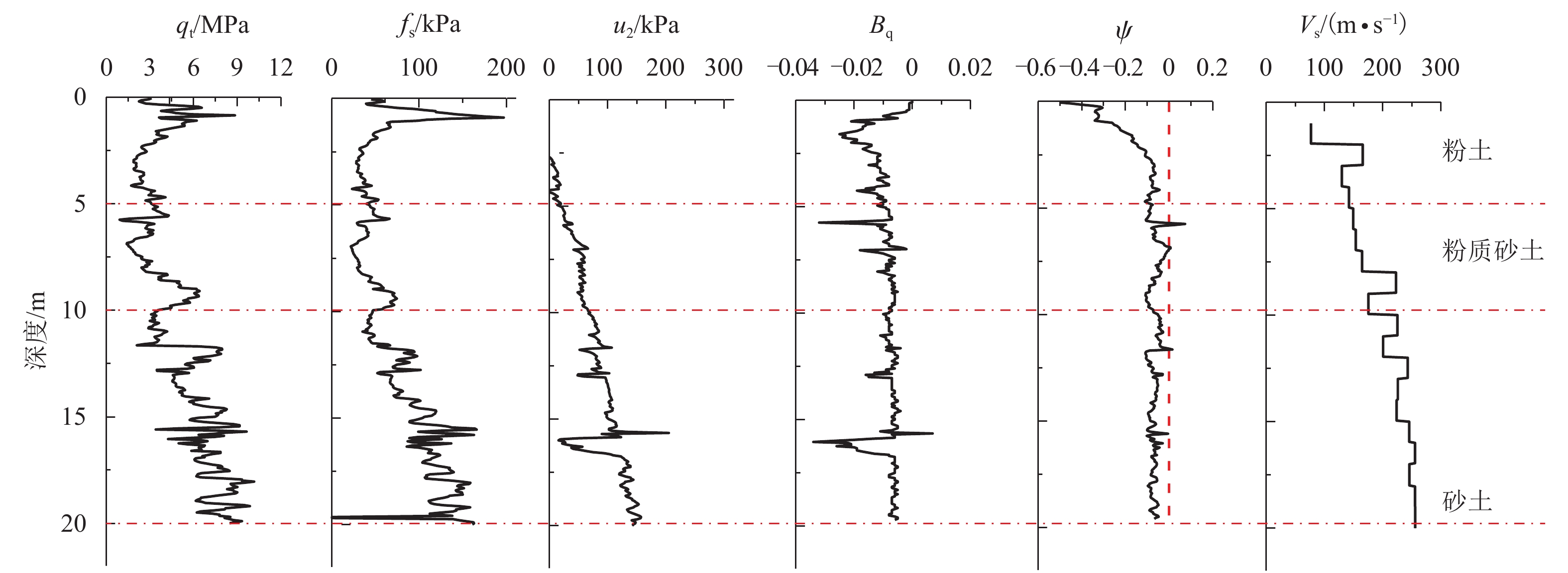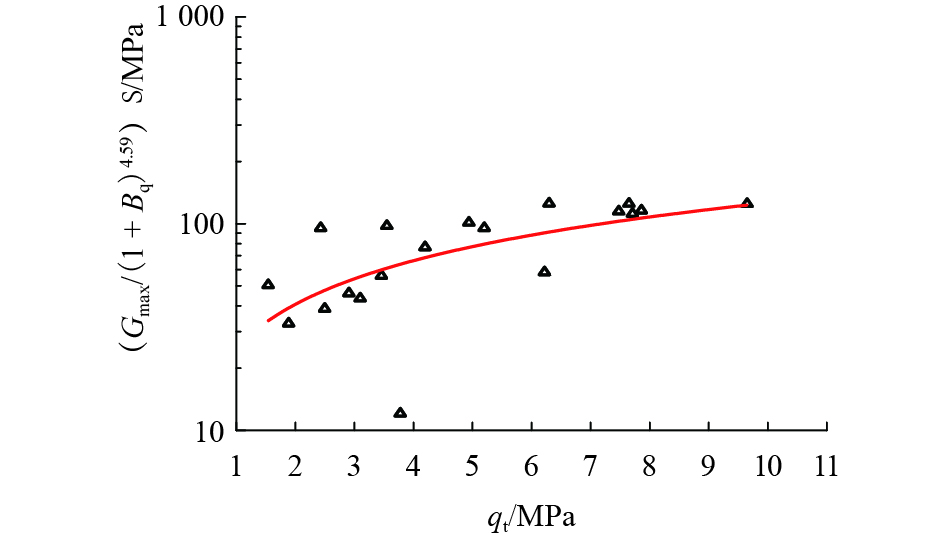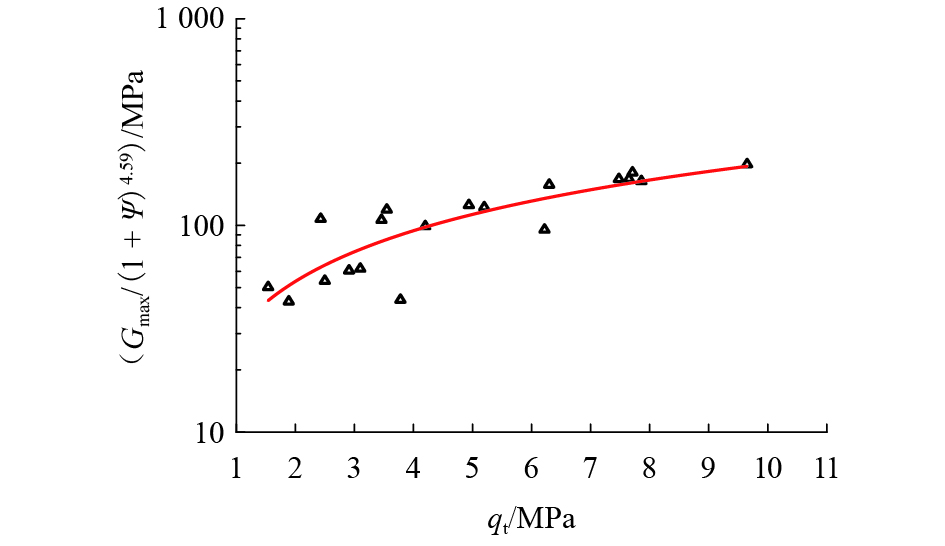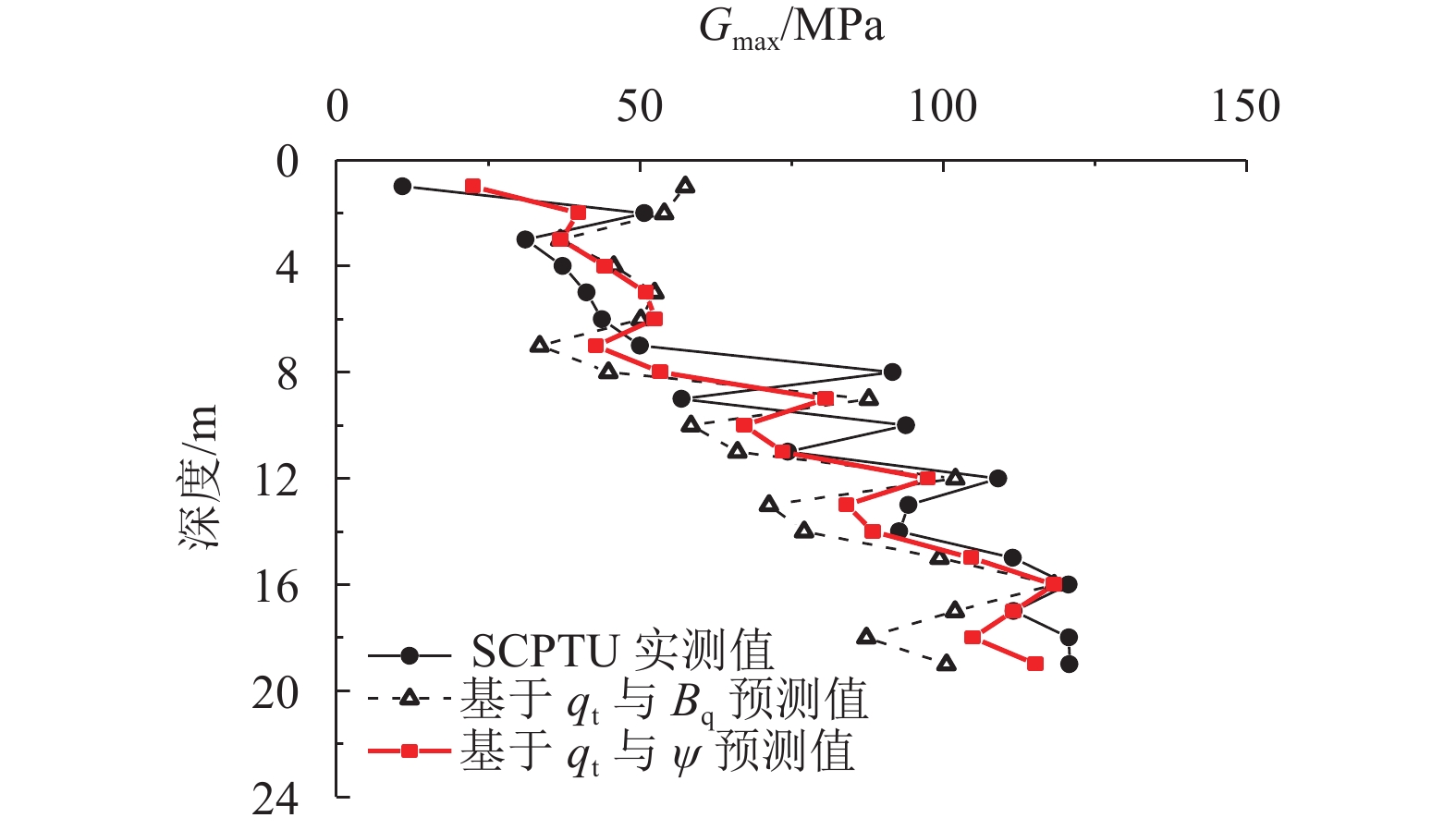Evaluation Method of Maximum Shear Modulus of Cohesionless Soil Based on State Parameters from Piezocone Penteration Test
-
摘要: 土体最大剪切模量是动力基础设计和地震场地响应分析的重要参数,目前该参数的确定主要来源于室内试验,但室内试验值难以反应现场土层的真实情况,因而采用原位测试技术确定土体最大剪切模量的方法备受关注. 以宿迁-新沂高速公路为工程背景,利用地震波孔压静力触探(SCPTU)对现场场地进行测试,在总结已有的最大剪切模量确定方法研究成果的基础上,以实测剪切波速计算得到的最大剪切模量作为参考值,研究了孔压静力触探(CPTU)测试参数与最大剪切模量之间的关系;基于临界状态土力学理论,研究了联合CPTU测试参数和状态参数与最大剪切模量的关系. 结果表明:最大剪切模量与CPTU测试参数存在良好的相关关系,可通过锥尖阻力和孔压参数来近似估计最大剪切模量值;将状态参数作为孔隙比或孔压参数比的有效代替参数,能够同时考虑围压应力与孔隙比双重因素,所估算的最大剪切模量与参考值基本一致. 因此,CPTU原位状态参数可作为一种新方法来初步评价无黏性土的最大剪切模量.Abstract: The maximum shear modulus of soil is an important parameter for dynamic design of foundations and response analysis of seismic sites. At present, this parameter is mainly determined through laboratory tests, but such tests cannot represent the real situation in the field. Thus, in situ testing technologies have attracted much attention. The Suqian-Xinji Expressway was regarded as the engineering background and seismic piezocone test (SCPTU) was conducted at the site. Based on the summary of research results for existing methods used to determine the maximum shear modulus, the relationship between the piezocone penetration test (CPTU) parameters and the maximum shear modulus was studied in terms of the reference value of the maximum shear modulus calculated using the measured shear wave velocity. The relationship between the joint CPTU parameters, state parameters, and maximum shear modulus was also analysed. The results show a good correlation between the maximum shear modulus and CPTU parameters. The maximum shear modulus value can be approximated by cone tip resistance and pore pressure parameters. The state parameter can serve as an effective alternative parameter for void ratio or pore pressure parameter ratio, and the dual factors of confining pressure and void ratio can be considered simultaneously. The estimated maximum shear modulus is the same as the reference value. Therefore, the in situ state parameters of CPTU can be used as a new method to evaluate the maximum shear modulus of cohesionless soil.
-
Key words:
- seismic piezocone test /
- sand /
- maximum shear modulus /
- shear wave velocity /
- state parameter
-
表 1 试验场地土层的主要物理力学性质指标
Table 1. Main physico-mechanical indexes of test site soils
层号 名称 深度/m 含水量/% 液限/% 标贯击数N ① 填土 1.0 11.27 31.47 9 ② 粉土 4.8 26.12 29.25 4 ③ 粉质砂土 6.0 29.48 28.43 10 ④ 砂土 未揭穿 27.72 27.64 24 -
HICHER P Y. Elastic properties of soils[J]. Journal of Geotechnical and Geoenvironmental Engineering,, 1996, 122(8): 641-648. CAI G J, PUPPALA A J, LIU S Y. Characterization on the correlation between shear wave velocity and piezocone tip resistance of Jiangsu clays[J]. Engineering Geology, 2014, 171(3): 96-103. TABOADA V M, ESPINOSA E, CARRASCO D, et al. Predictive equations of shear wave velocity for bay of campeche clay[C]//Offshore Technology Conference. Houston: [s.n.], 2013: 15-18 BALDI G, BELLOTTI R, GHIONNA V N, et al. Modulus of sands from CPT and DMT[C]//Proceedings of the 12th International Conference on Soil Mechanics and Foundation Engineering. Rotterdam: [s.n.], 1989, 1: 165-170 L’ HEUREUX J S, LONG M. Relationship between shear-wave velocity and geotechnical parameters for norwegianclays[J]. Journal of Geotechnical and Geoenvironmental Engineering, 2017, 143(6): 04017013. doi: 10.1061/(ASCE)GT.1943-5606.0001645 MAYNE P W, RIX G J. Gmax-qc relationships for clays[J]. Geotechnical Testing Journal, 1993, 16(1): 54-60. doi: 10.1520/GTJ10267J LUNNE T, ROBERTSON P K, POWELL J M. Cone penetration testing in geotechnical practice[M]. London: Blackie Academic and Professional, 1997: 15-18 蔡国军,刘松玉,童立元,等. 基于SCPTU的软土最大剪切模量测试分析研究[J]. 岩土力学,2008,29(9): 2556-2560. doi: 10.3969/j.issn.1000-7598.2008.09.045CAI Guojun, LIU Songyu, TONG Liyuan, et al. Evaluation of maximum shear modulus of soft clay from seismic piezocone tests (SCPTU)[J]. Rock and Soil Mechanics, 2008, 29(9): 2556-2560. doi: 10.3969/j.issn.1000-7598.2008.09.045 YANG J, LIU X. Shear wave velocity and stiffness of sand:the role of non-plastic fines[J]. Géotechnique, 2016, 66(6): 1-15. 赵成刚,尤昌龙. 饱和砂土液化与稳态强度[J]. 土木工程学报,2001,34(3): 90-96. doi: 10.3321/j.issn:1000-131X.2001.03.016ZHAO Chenggang, YOU Changlong. Liquefaction and steady state strength[J]. China Civil Engineering Journal, 2001, 34(3): 90-96. doi: 10.3321/j.issn:1000-131X.2001.03.016 YANG J. Discussion:non-uniqueness of flow liquefaction line for loose sand[J]. Géotechnique, 2004, 54(1): 66-68. doi: 10.1680/geot.2004.54.1.66 POLOUS S J. The steady state of deformation[J]. Journal of Geotechnical Engineering Division ASCE, 1981, 107(5): 553-562. BEEN K, JEFFERIES M G. A state parameter for sands[J]. Geotechnique, 1985, 35(2): 99-112. doi: 10.1680/geot.1985.35.2.99 储亚,蔡国军,刘松玉. 基于CPTU原位测试状态参数的液化判别方法研究[J]. 地震工程学报,2014,36(4): 905-910. doi: 10.3969/j.issn.1000-0844.2014.04.0905CHU Ya, CAI Guojun, LIU Songyu. Study on liquefaction evaluation method based on CPTU in-situ state parameter[J]. Journal of Earthquake Engineering, 2014, 36(4): 905-910. doi: 10.3969/j.issn.1000-0844.2014.04.0905 BEEN K, CROOKS J H A, JEFFERIES M G. Interpretation of material state from the CPT in sands and clays[C]//Penetration testing in the UK, Geotechnology Conference. Birmingham: [s.n.], 1989: 396-404 ROBERTSON P K, JAMES K. Mitchell lecture: interpretation of in-situ tests-some insights[C]//Proc. 4th Int. Conf. on Geotechnical and Geophysical Site Characterization-ISC’4. London: [s.n.], 2012: 3-24 PLEWES H D, DAVIES M P, JEFFERIES M G. CPT based screening procedure for evaluating liquefaction susceptibility[C]//Proceedings of the 45th Canadian Geotechnical Conference. Toronto: [s.n.], 1992: 1-9 BEEN K, JEFFERIES M G. Towards systematic CPT interpretation[C]//Predictive Soil Mechanics Proceedings of the Wroth Memorial Symposium, St Catherine's College. Oxford: [s.n.], 1992: 121-134 重庆交通科研设计院. 公路桥梁抗震设计细则: JTG/T B02-01—2008[S]. 北京: 人民交通出版社, 2008 KU T, MAYNE P W, CARGILL E. Continuous-interval shear wave velocity profiling by auto-source and seismic piezocone tests[J]. Canadian Geotechnical Journal, 2013, 50(4): 382-390. doi: 10.1139/cgj-2012-0278 JEFFERIES M G, BEEN K. Soil liquefaction: a critical state approach[M]. [S.l.]: Taylor & Francis, CRC Press, 2006: 5-14 LONG M, DONOHUE S. Characterization of norwegian marine clays with combined shear wave velocity and piezocone cone penetration test (CPTU) data[J]. Canadian Geotechnical Journal, 2010, 47(7): 709-718. doi: 10.1139/T09-133 SIMONINI P, COLA S. Use of piezocone to predict maximum stiffness of venetian soils[J]. Journal of Geotechnical and Geoenvironmental Engineering,ASCE, 2000, 126(4): 378-382. doi: 10.1061/(ASCE)1090-0241(2000)126:4(378) HARDIN B O, BLACK W L. Closure on vibration modulus of normally consolidated clay[J]. American Society of Civil Engineers, 1969, 6: 1531-1537. HARDIN B O. The nature of stress-strain behavior for soils[C]//In Earthquake Engineering and Soil Dynamics: Proceedings of the ASCE Geotechnical Engineering Division Specialty Conference. New York: American Society of Civil Engineers, 1978: 3-90 JAMIOLKOWSKI M, LEROUEIL S, LO PRESTI D C F. Theme lecture:design parameters from theory to practice[J]. Proceedings,Geo-Coast, 1991, 91: 1-41. RIX G J, STOKOE K H. Correlation of initial tangent modulus and cone penetration resistance[C]//International Symposium on Calibration Chamber Testing. New York: Elsevier Publishing, 1991: 351-362 BOUCKOVALAS G, KALTEZIOTIS N, SABATAKAKIS N, et al. Shear wave velocity in a very soft clay-measurement and correlations[C]//In Proceedings of the 12th International Conference on Soil Mechanics and Foundation Engineering. Rotterdam: [s.n.], 1989: 191-194 ANAGNOSTOPOULOS A, KOUKIS G, SABATAKAKIS N, et al. Empirical correlations of soil parameters based on cone penetration tests (CPT) for greek soils[J]. Geotechnical & Geological Engineering, 2003, 21(4): 377-387. -




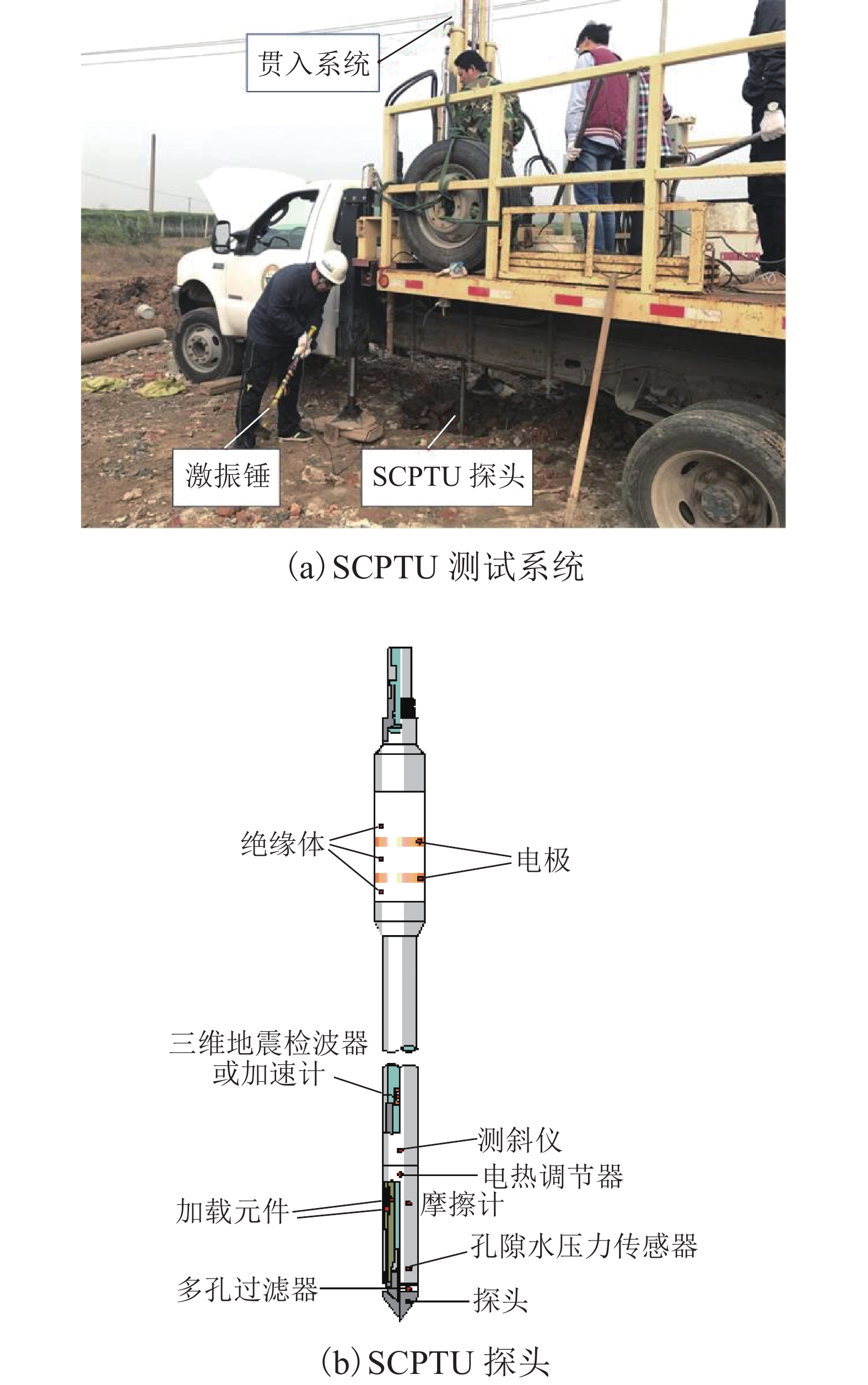
 下载:
下载:
